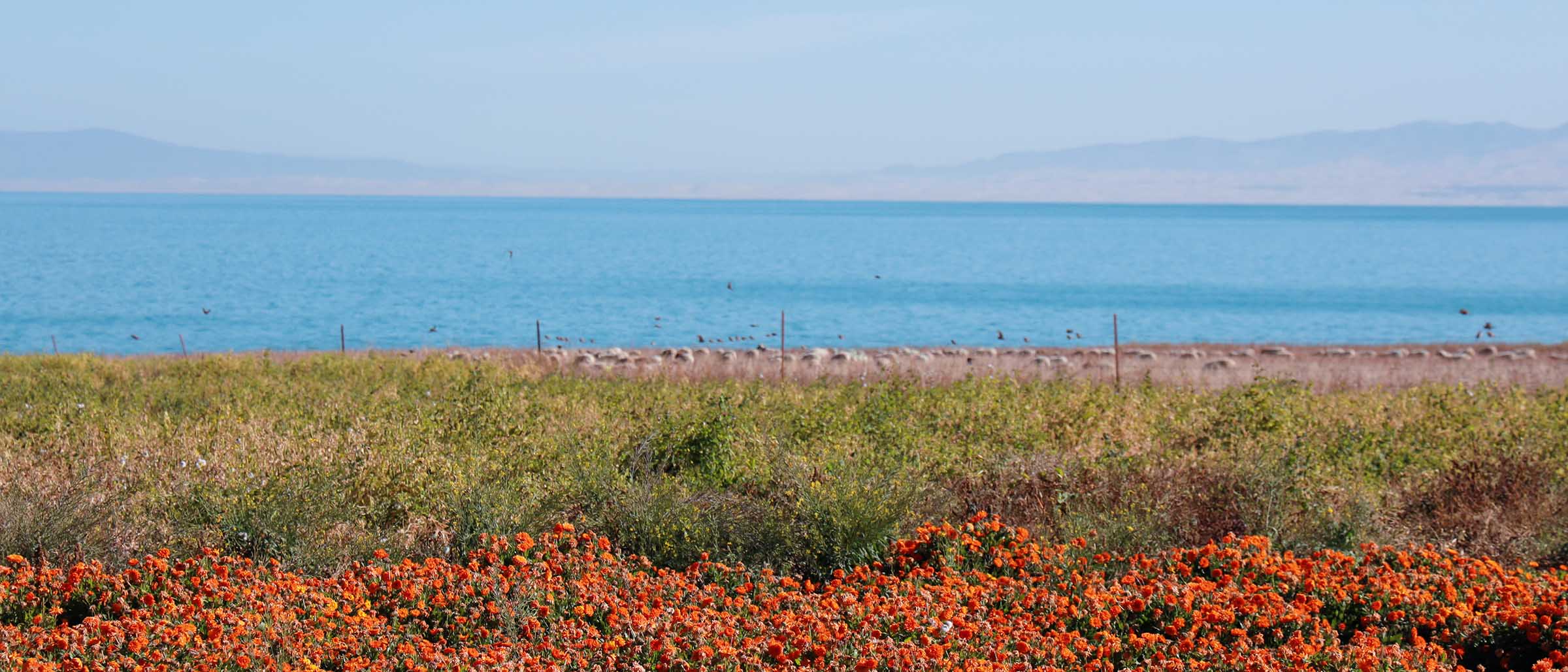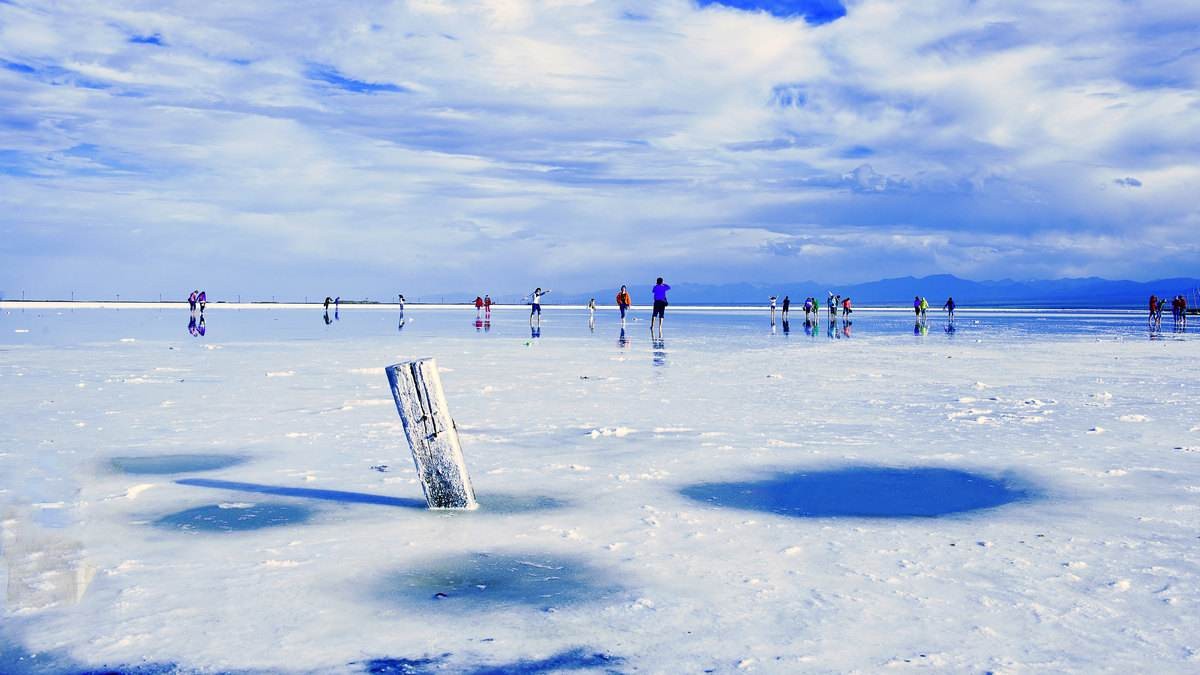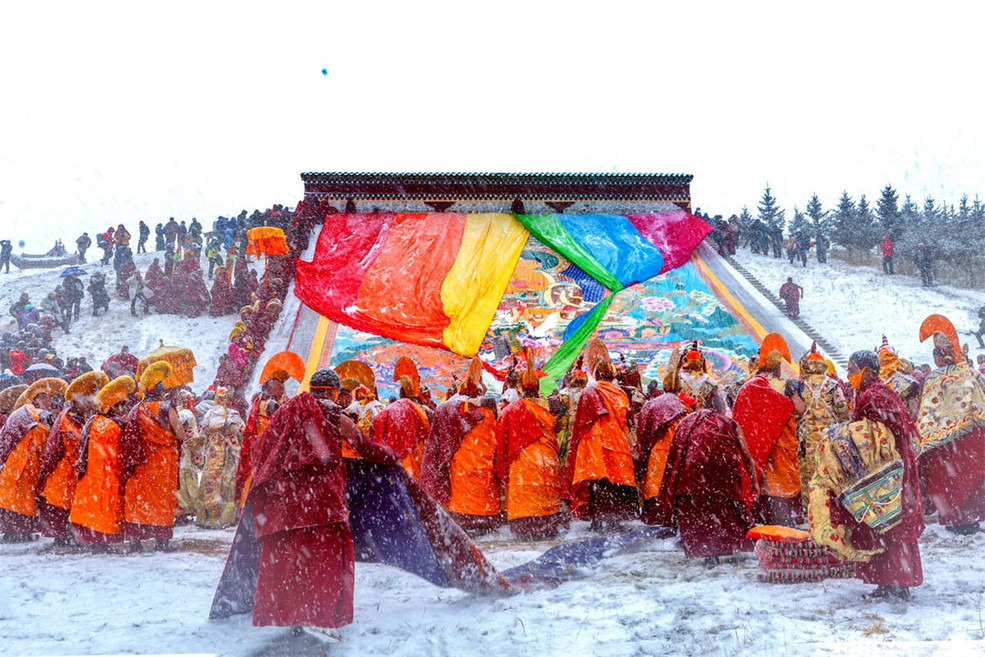- Qinghai -
Qinghai is one of the important province on China's Qinghai-Tibet Plateau. The Chinese name "Qinghai" is after Qinghai Lake, the largest lake in China. Located in the northwest region in China, Qinghai borders on Gansu , Sichaun , Tibet and Xinjiang provinces. It is the source of Chinese two largest rivers Yangtze River and Yellow River; and it is also the birthplace of the Lancang River. It is known as the "source of rivers" and "Chinese water tower".Qinghai is world-renown because of the Qinghai-Tibet Railway, Qinghai-Tibet Road, the southern route of Silk Road, and the Tang-Tibet Ancient Road as well as the Marco Polo Line. They all go through here.

Basic Information
Chinese Name: 青海(Qing Hai)
Location: Qinghai borders Gansu on the northeast, Xinjiang on the northwest, Sichuan on the southeast and the Tibet Autonomous Region on the southwest.
Provincial Capital: Xining
Area: 720thousand square kilometers, Qinghai is the largest province in the People's Republic of China (excluding the autonomous regions).
Population: The total population of Qinghai is 5.78 million.
Average Altitude: 3,000 meters.
Major Ethnic Groups: Zhuang, Hui, Mongolian
Famous City: Xining, Delingha, Golmud.
Qinghai Geography
Qinghai is located on the northeastern part of the Tibetan Plateau. The Yellow River originates in the southern part of the province, while the Yangtze and Mekong have their sources in the southwestern part. Qinghai is separated by the Riyue Mountain into pastoral and agricultural zones in the west and east.
By area, Qinghai is the largest province in the People's Republic of China. Qinghai Lake is the largest salt water lake in China, and the second largest in the world. The Qaidam basin lies in the northwest part of the province. About a third of this resource rich basin is desert. The basin has an altitude between 3000 and 3500 meters.
The Sanjiangyuan National Nature Reserve, is located in Qinghai and contains the headwaters of the Yellow River, Yangtze River, and Mekong River. The reserve was established to protect the headwaters of these three rivers and consists of 18 subareas, each containing three zones which are managed with differing degrees of strictness.
Qinghai Climate
The average elevation of Qinghai is over 3,000 metres above sea level.Mountain ranges include the Tanggula Mountains and Kunlun Mountains, with the highest point being Bukadaban Feng at 6,860 metres. Qinghai forms a distinctive plateau continental climate because of the interactions of the factors, such as, its elevation, its terrain, its latitude, its geographic location, atmospheric circulation, etc. It is long but not cold in winter, short and cool in summer, and four seasons change obscurely. Its mean annual temperature is approximately −5 to 8 °C, with January temperatures ranging from −18 to −7 °C and July temperatures ranging from 15 to 21 °C . It is also prone to heavy winds as well as sandstorms from February to April. Significant rainfall occurs mainly in summer, while precipitation is very low in winter and spring, and is generally low enough to keep much of the province semi-arid or arid.
Tourism Resources
Located on the northeastern part of the Tibetan Plateau, Qinghai is a province in China surrounded by Gansu Province on the north and east, Xinjiang Province on the west, Tibet on the south and Sichuan on the southeast. It is named after Qinghai Lake, the largest saltwater lake in China.
Qinghai now has 11 world-class scenic spots, 79 national-level spots, as well as hundreds of provincial-level scenic spots. More than 400 tourism resources have developing prospects, and quite a lot of them can be describe as China’s, and even world’s, greatest attraction. The most representative landscapes such as Qinghai Lake, the Three River source Region, the Qilian Mountain grassland, the clear Yellow River, as well as the Kunlun Mountains Culture, the Kumbum Monastery, Liu Wan’s Colorfully Painted Pottery, and local ethnic custom parks allow one to appreciate the Tibetan, Mongolian ans Salar folk culture, etc.
Qinghai is relatively unknown to foreign travelers. This huge area is home to many Tibetan monasteries, vast grasslands, the headwaters of the three of Asia largest rivers - the Yellow River, the Yangtze River and Mekong River. It also boasts of a mosaic of ethnic groups, including Tibetan, Mongols, Tu, Goloks and Hui with a vibrant religious life.
For foreign travelers, Qinghai is one of the frontiers of adventure travel in China, a springboard for China' wildest travel for Lhasa by rail, Yushu by road, Gansu and Labrang Monastery by road, and further westward the ancient silk road to Xinjiang.
Qinghai Culture and Religion
Located mostly on the Tibetan Plateau, the province has long been a melting pot for a number of ethnic groups including the Han, Tibetans, Hui, Tu, Mongols and Salars. Tibetans constitute a fifth of the population of Qinghai and the Hui compose roughly a sixth of the population. There are over 37 recognized ethnic groups among Qinghai's population of 5.2 million, with national minorities making up a total of 45.5% of the population.The predominant religions in Qinghai are Chinese folk religions(including Taoist traditions and Confucianism) and Chinese Buddhism among the Han-Chinese. The large Tibetan population practices Tibetan schools of Buddhism or traditional Tibetan Bön religion, while the Hui-Chinese practice Islam. It is also a culturally intersection place where diversified cultures join together; including the Yangtze River, the Yellow River, the Indian civilization, the Islamic civilization, along with some ancient Greek culture and ancient Roman culture, which all originated here.
Qinghai Cuisine
Qinghai attracts tourists from all over the world, not only for its spectacular landscapes but also for its distinctive food culture. Each cuisine contains rich ethic specialties. People crave a gourmet month- watering snack.
Qinghai is one of the four major pastoral regions in China. Every herdsman here is a skillful cook. They specialize in cooking beef and mutton with a great look and taste. It is one of the traditional local delicious. Qinghai’s special drink, Tianpei-Sweet fermented barley, is made of highland barley with a sweet and refreshing taste which is quite similar to fermented glutinous rice wine. Gamianpian Noodles is a typical food for common Qinghai household. It can comes with or without soup. Stewing or boiling or stir-frieing, each cooking method turns out an unique taste.
There are also other kinds of delicious snakes like Fazi ( raft-shaped sausage), Naipi( a kind of cheese), Sanzi(fried noodle), Mashi(Pasta in soup), Assorted nuts and fruits, Niangpi (thin wheaten sheet), Steamed Beef Rendon, Braised Lamb Meat and so on.
Folk Festivals
Nadam Fair
Nadam means “entertainment” or “games” in Mongolian language. Nadam Fair is a Mongolian annual traditional festival, especially popular in Inner Mongolia, Gansu, Qinghai and Xinjiang. It contains traditional but popular Mongolian sports, such as wresting, horse racing, archery contests, Bulu racing, lassoing horses and Mongolian chess. In some places, some competitive events such as track and field events, tug-of-war, volleyball and basketball matches are also held. During the grand fair, people enjoy performances of martial arts, polo, archery on horseback, swordsmanship on horseback, a horse-walking race, as well as a motorcycle race. In the horse-walking event, the participating horses are all well trained and their four hooves are not allowed to leave the ground at the same time during the race. Nadam Fair is held every year in July and August, when there are rich rainfall, lush grasslands, flourishing livestock, fine weather and fresh air.
Corban Festival
Corban means “sacrifice”, and is a major Islamic rite to show obedience and faith to Allah. Corban Festival, or Eid al Adha, is one of the major Islamic festivals celebrated by Muslims in Qinghai. It is also called the Loyalty and Filial Piety Festival among Chinese Muslims. Corban Festival falls on the 10th day of the 12th month in the Islamic calendar, and is the last day of pilgrimage activities. On that day, Muslims speaking Chinese, Turkish and other languages gather at mosques in splendid attire to celebrate the festival. After the ceremony, people in good financial condition will butcher a cow or sheep and split the meat into three parts: one for the poor, one for relatives and one for themselves.
Horse Racing Festival
Horse-racing is a major sport in Qinghai, and is very popular in Beishan (Ledu County), which is part of Xunhua, and pasturing areas across and province. There are two kinds of horse races: one judges the rider for his speed and footwork skill while the other judges the rider only for speed. To win the race, the rider must be good at selecting, raising and training his horse, last but not least, the horse-racing, which is the climax of the whole event. Some spectators will present colorful silk scarfs, called Hada or Khata, to the winner, and friends, relatives and female family members will hang embroidered bags on the horse’s mane. The winning horse is colorfully decorated with the largest number of embroidered bags.
Hua’er Festival
On the sixth day of the sixth lunar month, people across Qinghai celebrate this colorful event, and the one held in the scenic area of Laoye Mountain in Datong, 36 kilometers away from Xining, the capital of Qinghai Province, is the most famous. That day, people gather on the mountain to sing “Hua’er” songs (folk songs of love in Qinghai) in groups divided by ages. Singing “Hua’er” songs is a way for local people to express their love and the Hua’er Festival offers them an opportunity to find love, express love and sing love songs. Many good folk singers stand out in the singing contests.
Chaka Salt Lake
Chinese name: 茶卡盐湖(Cha Ka Yan Hu)
Location: Chaka town, Wulan county, Hainan Tibetan Prefecture, Qinghai Province, about 300km from Xining.
Ticket: Entrance ticket CNY60.00 during 01May to 31Oct, CNY30.00 during 01Nov to 30Apr. Mini train CNY50.00, electric cart CNY10.00.
Estimated tour time:2-3 hours
Recommended time to visit: May-Oct
Nearby attractions: Qinghai Lake, Zhuo’er Mountain, Sun and Moon Mountain.

Situated in Chaka Town, the Chaka Salt Lake (Caka Salt Lake) is298 kilometers (85 miles) from Xining, capital of Qinghai. This natural crystallized saline lake is regarded as the eastern gateway to Qaidam Basin, which reserves the largest salt mine in the world. Lying at an altitude of 3,059 meters (10,036 feet), the lake is oval shape and covers an area of 105 square kilometers (40 square miles), ten times larger than the West Lake of Hangzhou.
However, it is the smallest among the several salt lakes in Qaidam area, but different from others for its coexistence of both solid and liquid salt. The snow-white lake bed and the crystal blue water against the azure sky win it the reputation of ‘Mirror of the Sky.’ Travel to such a beautiful world of salt embedded in the snowy mountains and verdant meadows, tourists would inevitably feel like they are in a fairyland.
The beautiful sunrise and sunset sceneries are highly recommended. The best time to visit would be from July to August. It is believed that with the summer breeze, inhaling the humid air with its salt content is especially good for the lung. Its pureness, white and blue make it like a dreamland. It is rated as “one of the 55 places people must go” by Chinese National Geographic.
If you plan to visit the salt lake, you must take a train to get to the inner part of the lake. The caves and the endless salt lake are very special! It will take about 20 minutes to get to the center of the lake. There are a few visitors in the center of the lake. So you can take more beautiful pictures here.

Best Time to Visit
The best time to view the scenery of Chaka Salt Lake is in summer and autumn, especially on a sunny day. If it is sunny for several days, the lake water is of a high degree of crystallinity. And the white lake surface is covered with a thin layer of brine. You can see the most clear and pure scenery and reflections. In spring, you can visit the salt mining processes. In winter, you can enjoy the spectacular snow scenery.

- $1198.00
- 9D8N DAYS
01. Monlam Festival (or The Great Prayer Festival) is the grandest religious festival in Tibet, the 10-Day Amdo Tibetan Monlam Festival tour offers you an opportunity to attend festival events with thousands of local Tibetan nomads, you can …
Read More
- $948.00
- 7D6N DAYS
1. Kanbula National Park: Gazing out across some of the most sublime mountain and river panoramas in the land, Stunning landscapes of Danxia Red Peaks and forest, lakes, Tibetan pastures, valley and monasteries on the peaks.2. Qinghai Lake :…
Read More